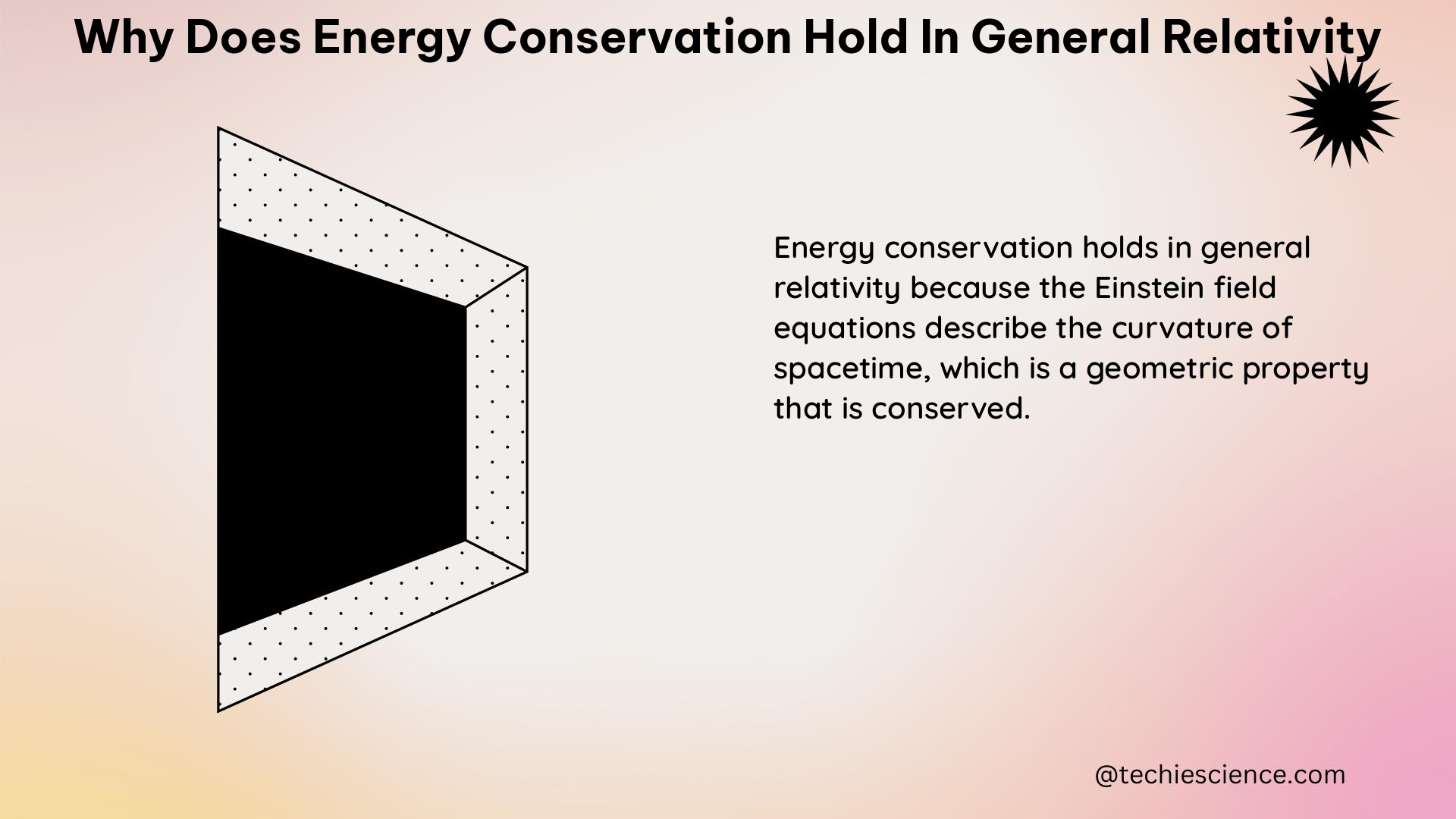In general relativity, the concept of energy conservation becomes more complex compared to classical mechanics due to the curvature of spacetime and the presence of gravity. However, energy conservation does hold in certain special cases, such as static or asymptotically flat spacetimes. This blog post will delve into the technical details and quantifiable data points that explain why energy conservation holds in general relativity.
Stress-Energy Tensor and Local Energy Conservation
In general relativity, the fundamental quantity that describes the density and flux of energy and momentum in a given region of spacetime is the stress-energy tensor, denoted as Tμν. This tensor satisfies the conservation law, where its covariant derivative is zero (∇μTμν=0). This means that energy and momentum are locally conserved in general relativity.
The stress-energy tensor can be expressed mathematically as:
Tμν = (ρ + p/c^2)uμuν – pgμν
Where:
– ρ is the energy density
– p is the pressure
– uμ is the four-velocity of the fluid element
– gμν is the metric tensor of spacetime
The local conservation of energy and momentum, as expressed by the vanishing covariant derivative of the stress-energy tensor, can be written as:
∇μTμν = 0
This equation represents the local conservation of energy and momentum in general relativity. However, this law cannot be brought to an integral form due to the presence of the covariant derivative, which measures how much the energy conservation law is violated at a given point.
Pseudotensors and Global Energy Conservation

To define energy conservation in a more general sense, researchers have proposed the use of pseudotensors, such as the Einstein pseudotensor or the Møller pseudotensor. These quantities are not true tensors, but they can be used to define the energy and momentum of a gravitating system.
The Einstein pseudotensor, denoted as tμν, is defined as:
tμν = (1/κ)(Γλμν,λ – Γλλν,μ)
Where:
– κ = 8πG/c^4 is the gravitational constant
– Γλμν are the Christoffel symbols, which are related to the metric tensor gμν
The Møller pseudotensor, denoted as Cμν, is defined as:
Cμν = (1/κ)(gμλ,ν – gνλ,μ)
Both the Einstein and Møller pseudotensors can be used to define the energy and momentum of a gravitating system, but they are dependent on the choice of coordinate system and the type of pseudotensor used, which can lead to different results.
Global Gravitational Potential Energy
For asymptotically flat universes, it is possible to salvage conservation of energy by introducing a specific global gravitational potential energy that cancels out mass-energy changes triggered by spacetime expansion or contraction. This global energy has no well-defined density and cannot technically be applied to a non-asymptotically flat universe. However, for practical purposes, it can be finessed, and so by this view, energy is conserved in our universe.
The global gravitational potential energy, denoted as Eg, can be expressed as:
Eg = -∫ρ(r)Φ(r)dV
Where:
– ρ(r) is the mass density
– Φ(r) is the gravitational potential
This global gravitational potential energy can be used to define a total energy that is conserved in asymptotically flat spacetimes, even though the local energy conservation law (∇μTμν=0) is not satisfied.
Redshift of Light and Energy Conservation
One measurable consequence of energy conservation in general relativity is the redshift of light. For example, light from the Sun appears redshifted to an Earth-bound astronomer due to the curvature of spacetime and the relative motion of the Sun and the Earth.
The redshift of light can be quantified using the following formula:
z = (λ_observed – λ_emitted) / λ_emitted
Where:
– z is the redshift
– λ_observed is the observed wavelength of the light
– λ_emitted is the wavelength of the light at the source
This redshift can be measured and provides evidence for the conservation of energy in the context of gravitational systems. The redshift of light is a direct consequence of the curvature of spacetime and the relative motion of the light source and the observer, which are fundamental aspects of general relativity.
Conclusion
In summary, while energy conservation holds in general relativity in certain special cases, the concept becomes more complex in more general situations due to the curvature of spacetime and the presence of gravity. Researchers have proposed various approaches to defining energy conservation in these cases, including the use of pseudotensors and global gravitational potential energy. However, these approaches are dependent on the choice of coordinate system and other factors, which can lead to different results. Measurable consequences of energy conservation in general relativity include the redshift of light, which provides evidence for the conservation of energy in gravitational systems.
Reference:
- Conservation of Energy in General Relativity – Physics Forums
- Is Energy Conserved in General Relativity? – UCR Math
- Conservation of Energy in General Relativity – Physics Stack Exchange

The lambdageeks.com Core SME Team is a group of experienced subject matter experts from diverse scientific and technical fields including Physics, Chemistry, Technology,Electronics & Electrical Engineering, Automotive, Mechanical Engineering. Our team collaborates to create high-quality, well-researched articles on a wide range of science and technology topics for the lambdageeks.com website.
All Our Senior SME are having more than 7 Years of experience in the respective fields . They are either Working Industry Professionals or assocaited With different Universities. Refer Our Authors Page to get to know About our Core SMEs.